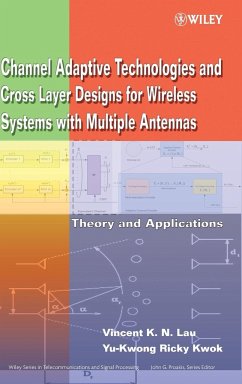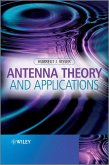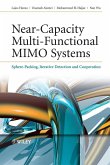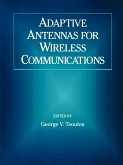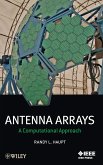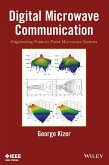Vincent K N Lau, Yu-Kwong Ricky Kwok
Channel-Adaptive Technologies and Cross-Layer Designs for Wireless Systems with Multiple Antennas
Theory and Applications
Vincent K N Lau, Yu-Kwong Ricky Kwok
Channel-Adaptive Technologies and Cross-Layer Designs for Wireless Systems with Multiple Antennas
Theory and Applications
- Gebundenes Buch
- Merkliste
- Auf die Merkliste
- Bewerten Bewerten
- Teilen
- Produkt teilen
- Produkterinnerung
- Produkterinnerung
Channel Adaptive Technologies for Wireless and Mobile Networking with Single/Multiple Antennas provides complete coverage of the latest theories (joint application of queuing theory and information theory) and practical industrial design considerations for communication systems with various levels of feedback. The book includes examples of popular wireless systems, such as TDMA, wideband CDMA, 3G1x and UMTS. Finally, the book includes in-depth discussion of several advanced topics such as wideband scheduler and applications to OFDM systems.
This innovative book sets forth two promising…mehr
Andere Kunden interessierten sich auch für
![Antenna Theory and Applications Antenna Theory and Applications]() Hubregt J VisserAntenna Theory and Applications94,99 €
Hubregt J VisserAntenna Theory and Applications94,99 €![Near-Capacity Multi-Functional MIMO Systems Near-Capacity Multi-Functional MIMO Systems]() Lajos HanzoNear-Capacity Multi-Functional MIMO Systems224,99 €
Lajos HanzoNear-Capacity Multi-Functional MIMO Systems224,99 €![Adaptive Antennas for Wireless Communications Adaptive Antennas for Wireless Communications]() George V. Tsoulos (Hrsg.)Adaptive Antennas for Wireless Communications244,99 €
George V. Tsoulos (Hrsg.)Adaptive Antennas for Wireless Communications244,99 €![Antenna Arrays Antenna Arrays]() Randy L HauptAntenna Arrays145,99 €
Randy L HauptAntenna Arrays145,99 €![Radio Propagation Measurement and Channel Modelling Radio Propagation Measurement and Channel Modelling]() Sana SalousRadio Propagation Measurement and Channel Modelling133,99 €
Sana SalousRadio Propagation Measurement and Channel Modelling133,99 €![Digital Microwave Communication Digital Microwave Communication]() George KizerDigital Microwave Communication150,99 €
George KizerDigital Microwave Communication150,99 €![Planar Antennas for Wireless Communications Planar Antennas for Wireless Communications]() Kin-Lu WongPlanar Antennas for Wireless Communications182,99 €
Kin-Lu WongPlanar Antennas for Wireless Communications182,99 €-
-
-
Channel Adaptive Technologies for Wireless and Mobile Networking with Single/Multiple Antennas provides complete coverage of the latest theories (joint application of queuing theory and information theory) and practical industrial design considerations for communication systems with various levels of feedback. The book includes examples of popular wireless systems, such as TDMA, wideband CDMA, 3G1x and UMTS. Finally, the book includes in-depth discussion of several advanced topics such as wideband scheduler and applications to OFDM systems.
This innovative book sets forth two promising wireless approaches that support high-quality, high-speed data and multimedia service-multiple antenna technologies and cross layer transmitter adaptation designs-while highlighting the relationships and interactions between them. The latest advanced technologies of channel adaptation techniques for wireless communication systems with multiple antennas are thoroughly investigated. The book is divided into three parts, first giving readers a good foundation in underlying theory, then exploring applications as well as advanced topics: * Part 1 examines theoretical aspects of channel adaptation in wireless communications for point-to-point and multi-user systems with multiple antennas * Part 2 focuses on the applications of the channel-adaptive technologies in practical systems such as UMTS * Part 3 delves into topics such as multi-user scheduling for wideband systems, combined queuing theory and information theory, and ad hoc routing Using a hands-on, practical approach, Channel Adaptive Technologies and Cross Layer Designs for Wireless Systems with Multiple Antennas thoroughly covers detailed design considerations that help readers understand how to apply theory to real-world systems. Emphasis throughout the book is on joint optimization across different layers of a communications system based on an integrated approach. Examples of popular wireless systems, such as TDMA, wideband CDMA (UMTS), and HSDPA, are used throughout as practical illustrations. Each chapter ends with a summary that reviews key points and a set of problems that lets readers test their knowledge and continue to develop their skills as they progress to new topics. Figures and tables are also used extensively to help readers visualize complex theory and systems. Combining theory, design, and application into one integrated approach, this is a superior reference for advanced communications theory courses.
This innovative book sets forth two promising wireless approaches that support high-quality, high-speed data and multimedia service-multiple antenna technologies and cross layer transmitter adaptation designs-while highlighting the relationships and interactions between them. The latest advanced technologies of channel adaptation techniques for wireless communication systems with multiple antennas are thoroughly investigated. The book is divided into three parts, first giving readers a good foundation in underlying theory, then exploring applications as well as advanced topics: * Part 1 examines theoretical aspects of channel adaptation in wireless communications for point-to-point and multi-user systems with multiple antennas * Part 2 focuses on the applications of the channel-adaptive technologies in practical systems such as UMTS * Part 3 delves into topics such as multi-user scheduling for wideband systems, combined queuing theory and information theory, and ad hoc routing Using a hands-on, practical approach, Channel Adaptive Technologies and Cross Layer Designs for Wireless Systems with Multiple Antennas thoroughly covers detailed design considerations that help readers understand how to apply theory to real-world systems. Emphasis throughout the book is on joint optimization across different layers of a communications system based on an integrated approach. Examples of popular wireless systems, such as TDMA, wideband CDMA (UMTS), and HSDPA, are used throughout as practical illustrations. Each chapter ends with a summary that reviews key points and a set of problems that lets readers test their knowledge and continue to develop their skills as they progress to new topics. Figures and tables are also used extensively to help readers visualize complex theory and systems. Combining theory, design, and application into one integrated approach, this is a superior reference for advanced communications theory courses.
Produktdetails
- Produktdetails
- Verlag: John Wiley & Sons / Wiley
- Seitenzahl: 544
- Erscheinungstermin: 1. Februar 2006
- Englisch
- Abmessung: 240mm x 161mm x 34mm
- Gewicht: 977g
- ISBN-13: 9780471648659
- ISBN-10: 0471648655
- Artikelnr.: 22231394
- Herstellerkennzeichnung
- Libri GmbH
- Europaallee 1
- 36244 Bad Hersfeld
- gpsr@libri.de
- Verlag: John Wiley & Sons / Wiley
- Seitenzahl: 544
- Erscheinungstermin: 1. Februar 2006
- Englisch
- Abmessung: 240mm x 161mm x 34mm
- Gewicht: 977g
- ISBN-13: 9780471648659
- ISBN-10: 0471648655
- Artikelnr.: 22231394
- Herstellerkennzeichnung
- Libri GmbH
- Europaallee 1
- 36244 Bad Hersfeld
- gpsr@libri.de
Deborah Lau was born in Hong Kong but grew up in Australia. As a child, she loved to read but hated Chinese school: there was too much rote memorisation and not enough fun.When her daughter turned 3, Deborah searched for Chinese/bilingual books like her beloved English children's classics: captivating stories with vivid characters told in everyday language--but she struggled. Most are written for Mandarin speakers or assume the adult reader is fluent--and she can't even read the Chinese menu in a restaurant. It was hard to keep her daughter interested when she always had to stop reading to look up or explain the Chinese characters and phrases (especially since standard written Chinese is very different to spoken Cantonese). So she wrote a book they could read together--without a dictionary!
List of Figures.
List of Tables.
Preface.
Acknowledgments.
PART 1: THEORY.
Chapter 1. Basic Concepts in Wireless Communications.
1.1 Overview.
1.2 Wireless Channel Models.
1.2.1 AWGN Channel Model.
1.2.2 Linear Time-Varying Deterministic Spatial Channel.
1.2.3 The Random Channels.
1.2.4 Frequency-Flat Fading Channels.
1.2.5 Frequency-Selective Fading Channels.
1.3 Equivalence of Continuous-Time and Discrete-Time Models.
1.3.1 Concepts of Signal Space.
1.3.2 Sufficient Statistics.
1.3.3 Discrete-Time Signal Model-Flat Fading.
1.3.4 Discrete-Time Channel Model-Frequency-Selective Fading.
1.4 Fundamentals of Information Theory.
1.4.1 Entropy and Mutual Information.
1.4.2 Shannon's Channel Coding Theorem.
1.4.3 Examples of Channel Capacity.
1.5 Summary.
Exercises.
Chapter 2. MIMO Link with Perfect Channel State Information.
2.1 Overview.
2.2 Mathematical Model of the MIMO Link.
2.2.1 Probabilistic Channels with States.
2.2.2 General Transmission and CSI Feedback Model.
2.2.3 Adaptive-Channel Encoding and Decoding.
2.2.4 Transmit Power Constraint.
2.2.5 Causal Feedback Constraint.
2.3 Ergodic and Outage Channel Capacity.
2.3.1 Ergodic Capacity.
2.3.2 Outage Capacity.
2.4 Channel Capacity with No CSIT and No CSIR.
2.4.1 Fast Flat Fading MIMO Channels.
2.4.2 Block Fading Channels.
2.5 Channel Capacity with Perfect CSIR.
2.5.1 Block Fading Channels.
2.5.2 Fast Flat Fading MIMO Channels.
2.5.3 Effect of Antenna Correlation on Ergodic MIMO Capacity.
2.5.4 Slow Flat Fading MIMO Channels.
2.6 Channel Capacity with Perfect CSIT Only.
2.6.1 Discrete Block Fading Channels.
2.6.2 Discrete Channel with Three States.
2.6.3 Fast Flat Fading MIMO Channels.
2.6.4 Slow Flat Fading MIMO Channels.
2.7 Channel Capacity with Perfect CSIR and Perfect CSIT.
2.7.1 Fast Flat Fading MIMO Channels.
2.7.2 Slow Flat Fading MIMO Channels.
2.8 Summary.
Exercises.
Chapter 3. MIMO Link with Imperfect Channel State Information.
3.1 Overview.
3.2 Effect of Imperfect CSI Estimation.
3.2.1 CSI Estimation for MIMO Channels.
3.2.2 Capacity Bounds of MIMO Link.
3.3 Effect of Limited Feedback-Optimizing for SNR.
3.3.1 Introduction to Optimizing Effective SNR.
3.3.2 Grassmannian Line Packing.
3.3.3 Grassmannian Precoding for MIMO Systems-Spatial Diversity.
3.3.4 Grassmannian Precoding for MIMO Systems-Spatial Multiplexing.
3.4 Effect of Limited Feedback-Optimizing for Ergodic Capacity.
3.4.1 Channel Capacity with Partial CSIT.
3.4.2 Coding Theorem with Partial CSIT.
3.4.3 Equivalence with Vector Quantization Problem.
3.4.4 Fast Flat Fading MIMO Channels.
3.4.5 Lloyd's Algorithm.
3.4.6 Approximate Closed-Form Solution for Step 1.
3.4.7 Complexity of the Online Adaptation Strategy.
3.4.8 MMSE-SIC Receiver Structure.
3.4.9 Numerical Results and Discussion.
3.5 Summary.
Exercises.
Chapter 4. Spacetime Coding and Layered Spacetime Coding for MIMO with
Perfect Channel State Information.
4.1 Overview.
4.2 Design of MIMO Links with Perfect CSIR.
4.2.1 Spacetime Coding-Spatial Diversity.
4.2.2 Layered Spacetime Coding-Spatial Multiplexing.
4.2.3 Receiver Designs for Layered Spacetime Codes.
4.2.4 Optimal Architecture for Fast Flat Fading Channels.
4.2.5 Optimal Architecture for Slow Flat Fading Channels.
4.2.6 Fundamental Tradeoff between Spatial Diversity and Spatial
Multiplexing.
4.3 Switching Threshold Design for MIMO Adaptation with Perfect CSIT and
Perfect CSIR.
4.3.1 MIMO Transmitter and Adaptation Designs.
4.3.2 Optimization Problem-Quasistatic Fading Channels.
4.3.3 Equivalence to the Classical Vector Quantization Problem.
4.3.4 Results and Discussion.
4.4 Summary.
Exercises.
Chapter 5. MIMO Constellation Design with Imperfect Channel State
Information.
5.1 Overview.
5.2 Constellation Design for MIMO Channels with Imperfect CSIR.
5.2.1 System Model.
5.2.2 Design Criteria Based on Kullback-Leibler Distance.
5.2.3 Constellation Design Optimization.
5.2.4 Single-Transmit Antenna Example.
5.2.5 Multitransmit Antenna Example.
5.3 Spacetime Coding for MIMO Channels with Imperfect CSIR.
5.3.1 Overview of Coded Modulation in AWGN Channels.
5.3.2 Coded Modulation Design for MIMO Channels with Imperfect CSIR.
5.4 Summary.
Chapter 6. Cross-Layer Scheduling for Multiuser Systems with Multiple
Antennas.
6.1 Overview.
6.2 Multiuser System Performance.
6.2.1 Examples of System Utility.
6.2.2 Definition of Network Capacity.
6.2.3 Definition of Network Coverage.
6.3 System Models.
6.3.1 Multiuser MIMO Channel Model.
6.3.2 Multiuser Downlink Physical Layer Model.
6.3.3 MAC Layer Model.
6.4 Cross-Layer Optimization with Perfect CSIT.
6.4.1 Capacity-Optimized Scheduler Design.
6.4.2 Coverage-Optimized Scheduler Design.
6.4.3 Common Framework for Both Capacity-Optimized and Coverage-Optimized
Scheduling.
6.4.4 Optimal Solution-Single-Antenna Systems.
6.4.5 Optimal Solution-Multiple-Antenna Systems with OTBF Processing.
6.5 Low-Complexity Scheduling Algorithms.
6.5.1 Suboptimal Solution A-Greedy Algorithm.
6.5.2 Suboptimal Solution B-Genetic Algorithm.
6.6 Results and Discussion.
6.6.1 System Capacity Performance.
6.6.2 Proportional Fairness Performance.
6.6.3 Coverage Performance.
6.6.4 Tradeoff between Capacity and Coverage.
6.6.5 Efficiency of Multiuser Diversity.
6.6.6 Efficiency of Spatial Multiplexing.
6.6.7 Complexity Comparisons of Various Cross-Layer Algorithms.
6.7 Cross-Layer Scheduling with Imperfect Channel State Information.
6.7.1 Multiuser Physical Layer Model with Imperfect CSIT.
6.7.2 System Utility Function.
6.7.3 The Scheduling Problem Formulation.
6.7.4 The Optimal Scheduling Solution.
6.7.5 Suboptimal Solution.
6.7.6 Numerical Results.
6.8 Summary.
Appendix 6A: Proof of Lemma 6.2.
Appendix 6B: Calculation of Weights.
Appendix 6C: Proof of Lemma 6.3.
Appendix 6D: Proof of Lemma 6.4.
Appendix 6E: Proof of Lemma 1.10.
Appendix 6F: Proof of Lemma 6.5.
Appendix 6G: Optimal Power Allocation for Network Capacity Utility.
Appendix 6H: Asymptotic Distribution of Sk .
Exercises.
PART 2: DESIGN EXAMPLES AND APPLICATIONS.
Chapter 7. Review of MAC Layer Design for Wireless Systems.
7.1 Overview.
7.2 TDMA-Based MAC Layer Design.
7.2.1 ALOHA.
7.2.2 Slotted ALOHA.
7.2.3 PRMA.
7.2.4 TDMA with Request Subframe.
7.3 CDMA-Based MAC Layer Design.
7.4 Issues in Request Scheduling.
7.5 Design Example-a Jointly Adaptive TDMA MAC Protocol.
7.5.1 Overview of TDMA MAC Protocol Design.
7.5.2 Synergistic Channel-Adaptive Multiple Access.
7.6 Design Example-a Jointly Adaptive CDMA MAC Protocol.
7.6.1 Channel Adaptation in CDMA Systems.
7.6.2 Optimal and Near-Optimal Approaches.
7.6.3 Approaches that Maintain Fairness.
7.6.4 User-Oriented Heuristics.
7.7 Performance Comparisons.
7.8 Summary.
Exercises.
Chapter 8. Channel-Adaptive Wireless Fair Scheduling.
8.1 Overview.
8.2 Scheduling Model.
8.2.1 Fluid Fair Queueing.
8.2.2 Service Model.
8.2.3 A Motivating Example.
8.3 Design Framework.
8.3.1 Error-Free Service Model.
8.3.2 Lead-Lag Model.
8.3.3 Compensation Model.
8.3.4 Slot Queue and Packet Queue.
8.4 Fairness Notions.
8.4.1 Effort Fair and Outcome Fair.
8.4.2 Fairness Notions for Wireline Networks.
8.4.3 Fairness Notions for Wireless Networks.
8.4.4 Channel-Adaptive Fairness.
8.4.5 Comparison with Other Fairness Notions.
8.5 Wireless Packet Scheduling Algorithms.
8.5.1 Idealized Wireless Fair Queueing (IWFQ).
8.5.2 Channel-Condition-Independent Fair Queueing (CIFQ).
8.5.3 Server-Based Fairness Approach (SBFA).
8.5.4 Wireless Fair Service (WFS).
8.5.5 Utility-Based Opportunistic Scheduling.
8.5.6 Channel-Adaptive Fair Queueing.
8.6 Numerical Examples.
8.6.1 Parameters.
8.6.2 Scenario 1.
8.6.3 Scenario 2.
8.6.4 Scenario 3.
8.6.5 Scenario 4.
8.7 Channel-Adaptive Scheduling for CDMA Systems.
8.7.1 Code Allocation in Multicode CDMA Systems.
8.7.2 CAFQ for CDMA Systems.
8.8 Summary.
Exercises.
Chapter 9. Packet-Switched Data Services in W-CDMA Systems.
9.1 Overview.
9.2 UMTS Architecture.
9.2.1 Radio Interface.
9.2.2 PHY Layer.
9.2.3 MAC Layer.
9.2.4 RLC Layer.
9.2.5 RRC Layer.
9.3 Packet-Switched Connections in UMTS (Rel 99).
9.3.1 Radio Bearer for Packet-Switched Users.
9.3.2 Setup of Packet-Switched Connection.
9.3.3 Scheduling Algorithms.
9.3.4 Performance.
9.4 Packet Scheduling in HSDPA (Rel 5).
9.4.1 Key Enabling Technologies in HSDPA.
9.4.2 Scheduling Algorithms and Performance.
9.4.3 Continued Evolution.
9.5 Summary.
Exercises.
PART 3: ADVANCED TOPICS.
Chapter 10. Cross-Layer Scheduling for Wideband Systems.
10.1 Overview.
10.2 Overview of DS-CDMA/MISO and OFDM/MISO Systems.
10.2.1 Multiuser Physical Layer Model of DS-CDMA/MISO Systems.
10.2.2 Physical Layer Model of OFDMA/MISO Systems.
10.3 Cross-Layer Scheduling Design for DS-CDMA/MISO and OFDMA/MISO Systems.
10.3.1 Cross-Layer Design for DS-CDMA/MISO Systems.
10.3.2 Cross-Layer Design for OFDMA/MISO Systems.
10.4 Performance Comparisons of DS-CDMA- and OFDM-Based Systems.
10.4.1 Performance of DS-CDMA/MISO Systems.
10.4.2 Performance of OFDMA/MISO Systems.
10.4.3 Comparisons of DS-CDMA/MISO and OFDMA/MISO Systems.
10.5 Implementation Issues of OFDMA System.
10.5.1 Downlink versus Uplink.
10.5.2 Signal Model.
10.5.3 Effect of Timing Offsets.
10.5.4 Effect of Frequency Offsets.
10.6 Summary.
Exercises.
Chapter 11. Cross-Layer Scheduling Design Based on Queueing Theory and
Information Theory.
11.1 Overview.
11.1.1 Cross-Layer Scheduling Model.
11.2 Multiuser Physical Layer Model.
11.2.1 Graph Model.
11.2.2 on/off Channel Model.
11.2.3 Information-Theoretic Model.
11.3 Motivations for Cross-Layer Scheduling in Multiuser Wireless Networks.
11.4 Stability Region.
11.4.1 Stability Region of Time-Invariant Physical Layer.
11.4.2 Stability Region of Stochastic Physical Layer.
11.4.3 Scheduling Design for Stability.
11.5 Cross-Layer Scheduler Design for Delay Minimization.
11.5.1 Problem Formulation.
11.5.2 Optimal Solution.
11.5.3 Description of LQHPR Policy.
11.5.4 Performance of an Example System.
11.6 Summary.
Appendix 11A: Proof of Theorem 11.1 on Stability Region of Deterministic
Physical Layer.
Appendix 11B: Proof of Theorem 11.2 on Stability Region of Stochastic
Physical layer.
Appendix 11C: Proof of Theorem 11.3 on Throughput Optimality of MW
Scheduling.
Appendix 11D: Proof of Theorem 11.5 on Throughput Optimality of EXP
Scheduling.
Appendix 11E: Conditions for Stability of a Stochastic Process.
Appendix 11F: Proof of Theorem 11.6 on Throughput Optimality of Tse-Hanly
Policy.
Exercises.
Chapter 12. Channel-Adaptive Ad Hoc Routing.
12.1 Overview.
12.2 Background.
12.3 Overview of Ad Hoc Routing Protocols.
12.3.1 AODV Protocol.
12.3.2 DSDV Protocol.
12.3.3 DSR Protocol.
12.3.4 ABR Protocol.
12.3.5 Link State Routing Protocol.
12.4 Receiver-Initiated Channel-Adaptive (RICA) Routing.
12.4.1 Channel Model.
12.4.2 Route Discovery.
12.4.3 Broadcast of CSI Checking Packets.
12.4.4 Route Maintenance.
12.4.5 Route Updating.
12.4.6 Comparison with Other Protocols.
12.5 Performance Results.
12.5.1 Simulation Environment.
12.5.2 Average End-to-End Delay.
12.5.3 Successful Percentage of Packet Delivery.
12.5.4 Routing Control Overhead.
12.5.5 Scalability.
12.5.6 Varying Offered Traffic Load.
12.5.7 Quality of Routes.
12.5.8 Observations in the Simulations.
12.5.9 Critiques on the Four Protocols.
12.6 Summary.
Exercises.
References.
Topic Index.
List of Tables.
Preface.
Acknowledgments.
PART 1: THEORY.
Chapter 1. Basic Concepts in Wireless Communications.
1.1 Overview.
1.2 Wireless Channel Models.
1.2.1 AWGN Channel Model.
1.2.2 Linear Time-Varying Deterministic Spatial Channel.
1.2.3 The Random Channels.
1.2.4 Frequency-Flat Fading Channels.
1.2.5 Frequency-Selective Fading Channels.
1.3 Equivalence of Continuous-Time and Discrete-Time Models.
1.3.1 Concepts of Signal Space.
1.3.2 Sufficient Statistics.
1.3.3 Discrete-Time Signal Model-Flat Fading.
1.3.4 Discrete-Time Channel Model-Frequency-Selective Fading.
1.4 Fundamentals of Information Theory.
1.4.1 Entropy and Mutual Information.
1.4.2 Shannon's Channel Coding Theorem.
1.4.3 Examples of Channel Capacity.
1.5 Summary.
Exercises.
Chapter 2. MIMO Link with Perfect Channel State Information.
2.1 Overview.
2.2 Mathematical Model of the MIMO Link.
2.2.1 Probabilistic Channels with States.
2.2.2 General Transmission and CSI Feedback Model.
2.2.3 Adaptive-Channel Encoding and Decoding.
2.2.4 Transmit Power Constraint.
2.2.5 Causal Feedback Constraint.
2.3 Ergodic and Outage Channel Capacity.
2.3.1 Ergodic Capacity.
2.3.2 Outage Capacity.
2.4 Channel Capacity with No CSIT and No CSIR.
2.4.1 Fast Flat Fading MIMO Channels.
2.4.2 Block Fading Channels.
2.5 Channel Capacity with Perfect CSIR.
2.5.1 Block Fading Channels.
2.5.2 Fast Flat Fading MIMO Channels.
2.5.3 Effect of Antenna Correlation on Ergodic MIMO Capacity.
2.5.4 Slow Flat Fading MIMO Channels.
2.6 Channel Capacity with Perfect CSIT Only.
2.6.1 Discrete Block Fading Channels.
2.6.2 Discrete Channel with Three States.
2.6.3 Fast Flat Fading MIMO Channels.
2.6.4 Slow Flat Fading MIMO Channels.
2.7 Channel Capacity with Perfect CSIR and Perfect CSIT.
2.7.1 Fast Flat Fading MIMO Channels.
2.7.2 Slow Flat Fading MIMO Channels.
2.8 Summary.
Exercises.
Chapter 3. MIMO Link with Imperfect Channel State Information.
3.1 Overview.
3.2 Effect of Imperfect CSI Estimation.
3.2.1 CSI Estimation for MIMO Channels.
3.2.2 Capacity Bounds of MIMO Link.
3.3 Effect of Limited Feedback-Optimizing for SNR.
3.3.1 Introduction to Optimizing Effective SNR.
3.3.2 Grassmannian Line Packing.
3.3.3 Grassmannian Precoding for MIMO Systems-Spatial Diversity.
3.3.4 Grassmannian Precoding for MIMO Systems-Spatial Multiplexing.
3.4 Effect of Limited Feedback-Optimizing for Ergodic Capacity.
3.4.1 Channel Capacity with Partial CSIT.
3.4.2 Coding Theorem with Partial CSIT.
3.4.3 Equivalence with Vector Quantization Problem.
3.4.4 Fast Flat Fading MIMO Channels.
3.4.5 Lloyd's Algorithm.
3.4.6 Approximate Closed-Form Solution for Step 1.
3.4.7 Complexity of the Online Adaptation Strategy.
3.4.8 MMSE-SIC Receiver Structure.
3.4.9 Numerical Results and Discussion.
3.5 Summary.
Exercises.
Chapter 4. Spacetime Coding and Layered Spacetime Coding for MIMO with
Perfect Channel State Information.
4.1 Overview.
4.2 Design of MIMO Links with Perfect CSIR.
4.2.1 Spacetime Coding-Spatial Diversity.
4.2.2 Layered Spacetime Coding-Spatial Multiplexing.
4.2.3 Receiver Designs for Layered Spacetime Codes.
4.2.4 Optimal Architecture for Fast Flat Fading Channels.
4.2.5 Optimal Architecture for Slow Flat Fading Channels.
4.2.6 Fundamental Tradeoff between Spatial Diversity and Spatial
Multiplexing.
4.3 Switching Threshold Design for MIMO Adaptation with Perfect CSIT and
Perfect CSIR.
4.3.1 MIMO Transmitter and Adaptation Designs.
4.3.2 Optimization Problem-Quasistatic Fading Channels.
4.3.3 Equivalence to the Classical Vector Quantization Problem.
4.3.4 Results and Discussion.
4.4 Summary.
Exercises.
Chapter 5. MIMO Constellation Design with Imperfect Channel State
Information.
5.1 Overview.
5.2 Constellation Design for MIMO Channels with Imperfect CSIR.
5.2.1 System Model.
5.2.2 Design Criteria Based on Kullback-Leibler Distance.
5.2.3 Constellation Design Optimization.
5.2.4 Single-Transmit Antenna Example.
5.2.5 Multitransmit Antenna Example.
5.3 Spacetime Coding for MIMO Channels with Imperfect CSIR.
5.3.1 Overview of Coded Modulation in AWGN Channels.
5.3.2 Coded Modulation Design for MIMO Channels with Imperfect CSIR.
5.4 Summary.
Chapter 6. Cross-Layer Scheduling for Multiuser Systems with Multiple
Antennas.
6.1 Overview.
6.2 Multiuser System Performance.
6.2.1 Examples of System Utility.
6.2.2 Definition of Network Capacity.
6.2.3 Definition of Network Coverage.
6.3 System Models.
6.3.1 Multiuser MIMO Channel Model.
6.3.2 Multiuser Downlink Physical Layer Model.
6.3.3 MAC Layer Model.
6.4 Cross-Layer Optimization with Perfect CSIT.
6.4.1 Capacity-Optimized Scheduler Design.
6.4.2 Coverage-Optimized Scheduler Design.
6.4.3 Common Framework for Both Capacity-Optimized and Coverage-Optimized
Scheduling.
6.4.4 Optimal Solution-Single-Antenna Systems.
6.4.5 Optimal Solution-Multiple-Antenna Systems with OTBF Processing.
6.5 Low-Complexity Scheduling Algorithms.
6.5.1 Suboptimal Solution A-Greedy Algorithm.
6.5.2 Suboptimal Solution B-Genetic Algorithm.
6.6 Results and Discussion.
6.6.1 System Capacity Performance.
6.6.2 Proportional Fairness Performance.
6.6.3 Coverage Performance.
6.6.4 Tradeoff between Capacity and Coverage.
6.6.5 Efficiency of Multiuser Diversity.
6.6.6 Efficiency of Spatial Multiplexing.
6.6.7 Complexity Comparisons of Various Cross-Layer Algorithms.
6.7 Cross-Layer Scheduling with Imperfect Channel State Information.
6.7.1 Multiuser Physical Layer Model with Imperfect CSIT.
6.7.2 System Utility Function.
6.7.3 The Scheduling Problem Formulation.
6.7.4 The Optimal Scheduling Solution.
6.7.5 Suboptimal Solution.
6.7.6 Numerical Results.
6.8 Summary.
Appendix 6A: Proof of Lemma 6.2.
Appendix 6B: Calculation of Weights.
Appendix 6C: Proof of Lemma 6.3.
Appendix 6D: Proof of Lemma 6.4.
Appendix 6E: Proof of Lemma 1.10.
Appendix 6F: Proof of Lemma 6.5.
Appendix 6G: Optimal Power Allocation for Network Capacity Utility.
Appendix 6H: Asymptotic Distribution of Sk .
Exercises.
PART 2: DESIGN EXAMPLES AND APPLICATIONS.
Chapter 7. Review of MAC Layer Design for Wireless Systems.
7.1 Overview.
7.2 TDMA-Based MAC Layer Design.
7.2.1 ALOHA.
7.2.2 Slotted ALOHA.
7.2.3 PRMA.
7.2.4 TDMA with Request Subframe.
7.3 CDMA-Based MAC Layer Design.
7.4 Issues in Request Scheduling.
7.5 Design Example-a Jointly Adaptive TDMA MAC Protocol.
7.5.1 Overview of TDMA MAC Protocol Design.
7.5.2 Synergistic Channel-Adaptive Multiple Access.
7.6 Design Example-a Jointly Adaptive CDMA MAC Protocol.
7.6.1 Channel Adaptation in CDMA Systems.
7.6.2 Optimal and Near-Optimal Approaches.
7.6.3 Approaches that Maintain Fairness.
7.6.4 User-Oriented Heuristics.
7.7 Performance Comparisons.
7.8 Summary.
Exercises.
Chapter 8. Channel-Adaptive Wireless Fair Scheduling.
8.1 Overview.
8.2 Scheduling Model.
8.2.1 Fluid Fair Queueing.
8.2.2 Service Model.
8.2.3 A Motivating Example.
8.3 Design Framework.
8.3.1 Error-Free Service Model.
8.3.2 Lead-Lag Model.
8.3.3 Compensation Model.
8.3.4 Slot Queue and Packet Queue.
8.4 Fairness Notions.
8.4.1 Effort Fair and Outcome Fair.
8.4.2 Fairness Notions for Wireline Networks.
8.4.3 Fairness Notions for Wireless Networks.
8.4.4 Channel-Adaptive Fairness.
8.4.5 Comparison with Other Fairness Notions.
8.5 Wireless Packet Scheduling Algorithms.
8.5.1 Idealized Wireless Fair Queueing (IWFQ).
8.5.2 Channel-Condition-Independent Fair Queueing (CIFQ).
8.5.3 Server-Based Fairness Approach (SBFA).
8.5.4 Wireless Fair Service (WFS).
8.5.5 Utility-Based Opportunistic Scheduling.
8.5.6 Channel-Adaptive Fair Queueing.
8.6 Numerical Examples.
8.6.1 Parameters.
8.6.2 Scenario 1.
8.6.3 Scenario 2.
8.6.4 Scenario 3.
8.6.5 Scenario 4.
8.7 Channel-Adaptive Scheduling for CDMA Systems.
8.7.1 Code Allocation in Multicode CDMA Systems.
8.7.2 CAFQ for CDMA Systems.
8.8 Summary.
Exercises.
Chapter 9. Packet-Switched Data Services in W-CDMA Systems.
9.1 Overview.
9.2 UMTS Architecture.
9.2.1 Radio Interface.
9.2.2 PHY Layer.
9.2.3 MAC Layer.
9.2.4 RLC Layer.
9.2.5 RRC Layer.
9.3 Packet-Switched Connections in UMTS (Rel 99).
9.3.1 Radio Bearer for Packet-Switched Users.
9.3.2 Setup of Packet-Switched Connection.
9.3.3 Scheduling Algorithms.
9.3.4 Performance.
9.4 Packet Scheduling in HSDPA (Rel 5).
9.4.1 Key Enabling Technologies in HSDPA.
9.4.2 Scheduling Algorithms and Performance.
9.4.3 Continued Evolution.
9.5 Summary.
Exercises.
PART 3: ADVANCED TOPICS.
Chapter 10. Cross-Layer Scheduling for Wideband Systems.
10.1 Overview.
10.2 Overview of DS-CDMA/MISO and OFDM/MISO Systems.
10.2.1 Multiuser Physical Layer Model of DS-CDMA/MISO Systems.
10.2.2 Physical Layer Model of OFDMA/MISO Systems.
10.3 Cross-Layer Scheduling Design for DS-CDMA/MISO and OFDMA/MISO Systems.
10.3.1 Cross-Layer Design for DS-CDMA/MISO Systems.
10.3.2 Cross-Layer Design for OFDMA/MISO Systems.
10.4 Performance Comparisons of DS-CDMA- and OFDM-Based Systems.
10.4.1 Performance of DS-CDMA/MISO Systems.
10.4.2 Performance of OFDMA/MISO Systems.
10.4.3 Comparisons of DS-CDMA/MISO and OFDMA/MISO Systems.
10.5 Implementation Issues of OFDMA System.
10.5.1 Downlink versus Uplink.
10.5.2 Signal Model.
10.5.3 Effect of Timing Offsets.
10.5.4 Effect of Frequency Offsets.
10.6 Summary.
Exercises.
Chapter 11. Cross-Layer Scheduling Design Based on Queueing Theory and
Information Theory.
11.1 Overview.
11.1.1 Cross-Layer Scheduling Model.
11.2 Multiuser Physical Layer Model.
11.2.1 Graph Model.
11.2.2 on/off Channel Model.
11.2.3 Information-Theoretic Model.
11.3 Motivations for Cross-Layer Scheduling in Multiuser Wireless Networks.
11.4 Stability Region.
11.4.1 Stability Region of Time-Invariant Physical Layer.
11.4.2 Stability Region of Stochastic Physical Layer.
11.4.3 Scheduling Design for Stability.
11.5 Cross-Layer Scheduler Design for Delay Minimization.
11.5.1 Problem Formulation.
11.5.2 Optimal Solution.
11.5.3 Description of LQHPR Policy.
11.5.4 Performance of an Example System.
11.6 Summary.
Appendix 11A: Proof of Theorem 11.1 on Stability Region of Deterministic
Physical Layer.
Appendix 11B: Proof of Theorem 11.2 on Stability Region of Stochastic
Physical layer.
Appendix 11C: Proof of Theorem 11.3 on Throughput Optimality of MW
Scheduling.
Appendix 11D: Proof of Theorem 11.5 on Throughput Optimality of EXP
Scheduling.
Appendix 11E: Conditions for Stability of a Stochastic Process.
Appendix 11F: Proof of Theorem 11.6 on Throughput Optimality of Tse-Hanly
Policy.
Exercises.
Chapter 12. Channel-Adaptive Ad Hoc Routing.
12.1 Overview.
12.2 Background.
12.3 Overview of Ad Hoc Routing Protocols.
12.3.1 AODV Protocol.
12.3.2 DSDV Protocol.
12.3.3 DSR Protocol.
12.3.4 ABR Protocol.
12.3.5 Link State Routing Protocol.
12.4 Receiver-Initiated Channel-Adaptive (RICA) Routing.
12.4.1 Channel Model.
12.4.2 Route Discovery.
12.4.3 Broadcast of CSI Checking Packets.
12.4.4 Route Maintenance.
12.4.5 Route Updating.
12.4.6 Comparison with Other Protocols.
12.5 Performance Results.
12.5.1 Simulation Environment.
12.5.2 Average End-to-End Delay.
12.5.3 Successful Percentage of Packet Delivery.
12.5.4 Routing Control Overhead.
12.5.5 Scalability.
12.5.6 Varying Offered Traffic Load.
12.5.7 Quality of Routes.
12.5.8 Observations in the Simulations.
12.5.9 Critiques on the Four Protocols.
12.6 Summary.
Exercises.
References.
Topic Index.
List of Figures.
List of Tables.
Preface.
Acknowledgments.
PART 1: THEORY.
Chapter 1. Basic Concepts in Wireless Communications.
1.1 Overview.
1.2 Wireless Channel Models.
1.2.1 AWGN Channel Model.
1.2.2 Linear Time-Varying Deterministic Spatial Channel.
1.2.3 The Random Channels.
1.2.4 Frequency-Flat Fading Channels.
1.2.5 Frequency-Selective Fading Channels.
1.3 Equivalence of Continuous-Time and Discrete-Time Models.
1.3.1 Concepts of Signal Space.
1.3.2 Sufficient Statistics.
1.3.3 Discrete-Time Signal Model-Flat Fading.
1.3.4 Discrete-Time Channel Model-Frequency-Selective Fading.
1.4 Fundamentals of Information Theory.
1.4.1 Entropy and Mutual Information.
1.4.2 Shannon's Channel Coding Theorem.
1.4.3 Examples of Channel Capacity.
1.5 Summary.
Exercises.
Chapter 2. MIMO Link with Perfect Channel State Information.
2.1 Overview.
2.2 Mathematical Model of the MIMO Link.
2.2.1 Probabilistic Channels with States.
2.2.2 General Transmission and CSI Feedback Model.
2.2.3 Adaptive-Channel Encoding and Decoding.
2.2.4 Transmit Power Constraint.
2.2.5 Causal Feedback Constraint.
2.3 Ergodic and Outage Channel Capacity.
2.3.1 Ergodic Capacity.
2.3.2 Outage Capacity.
2.4 Channel Capacity with No CSIT and No CSIR.
2.4.1 Fast Flat Fading MIMO Channels.
2.4.2 Block Fading Channels.
2.5 Channel Capacity with Perfect CSIR.
2.5.1 Block Fading Channels.
2.5.2 Fast Flat Fading MIMO Channels.
2.5.3 Effect of Antenna Correlation on Ergodic MIMO Capacity.
2.5.4 Slow Flat Fading MIMO Channels.
2.6 Channel Capacity with Perfect CSIT Only.
2.6.1 Discrete Block Fading Channels.
2.6.2 Discrete Channel with Three States.
2.6.3 Fast Flat Fading MIMO Channels.
2.6.4 Slow Flat Fading MIMO Channels.
2.7 Channel Capacity with Perfect CSIR and Perfect CSIT.
2.7.1 Fast Flat Fading MIMO Channels.
2.7.2 Slow Flat Fading MIMO Channels.
2.8 Summary.
Exercises.
Chapter 3. MIMO Link with Imperfect Channel State Information.
3.1 Overview.
3.2 Effect of Imperfect CSI Estimation.
3.2.1 CSI Estimation for MIMO Channels.
3.2.2 Capacity Bounds of MIMO Link.
3.3 Effect of Limited Feedback-Optimizing for SNR.
3.3.1 Introduction to Optimizing Effective SNR.
3.3.2 Grassmannian Line Packing.
3.3.3 Grassmannian Precoding for MIMO Systems-Spatial Diversity.
3.3.4 Grassmannian Precoding for MIMO Systems-Spatial Multiplexing.
3.4 Effect of Limited Feedback-Optimizing for Ergodic Capacity.
3.4.1 Channel Capacity with Partial CSIT.
3.4.2 Coding Theorem with Partial CSIT.
3.4.3 Equivalence with Vector Quantization Problem.
3.4.4 Fast Flat Fading MIMO Channels.
3.4.5 Lloyd's Algorithm.
3.4.6 Approximate Closed-Form Solution for Step 1.
3.4.7 Complexity of the Online Adaptation Strategy.
3.4.8 MMSE-SIC Receiver Structure.
3.4.9 Numerical Results and Discussion.
3.5 Summary.
Exercises.
Chapter 4. Spacetime Coding and Layered Spacetime Coding for MIMO with
Perfect Channel State Information.
4.1 Overview.
4.2 Design of MIMO Links with Perfect CSIR.
4.2.1 Spacetime Coding-Spatial Diversity.
4.2.2 Layered Spacetime Coding-Spatial Multiplexing.
4.2.3 Receiver Designs for Layered Spacetime Codes.
4.2.4 Optimal Architecture for Fast Flat Fading Channels.
4.2.5 Optimal Architecture for Slow Flat Fading Channels.
4.2.6 Fundamental Tradeoff between Spatial Diversity and Spatial
Multiplexing.
4.3 Switching Threshold Design for MIMO Adaptation with Perfect CSIT and
Perfect CSIR.
4.3.1 MIMO Transmitter and Adaptation Designs.
4.3.2 Optimization Problem-Quasistatic Fading Channels.
4.3.3 Equivalence to the Classical Vector Quantization Problem.
4.3.4 Results and Discussion.
4.4 Summary.
Exercises.
Chapter 5. MIMO Constellation Design with Imperfect Channel State
Information.
5.1 Overview.
5.2 Constellation Design for MIMO Channels with Imperfect CSIR.
5.2.1 System Model.
5.2.2 Design Criteria Based on Kullback-Leibler Distance.
5.2.3 Constellation Design Optimization.
5.2.4 Single-Transmit Antenna Example.
5.2.5 Multitransmit Antenna Example.
5.3 Spacetime Coding for MIMO Channels with Imperfect CSIR.
5.3.1 Overview of Coded Modulation in AWGN Channels.
5.3.2 Coded Modulation Design for MIMO Channels with Imperfect CSIR.
5.4 Summary.
Chapter 6. Cross-Layer Scheduling for Multiuser Systems with Multiple
Antennas.
6.1 Overview.
6.2 Multiuser System Performance.
6.2.1 Examples of System Utility.
6.2.2 Definition of Network Capacity.
6.2.3 Definition of Network Coverage.
6.3 System Models.
6.3.1 Multiuser MIMO Channel Model.
6.3.2 Multiuser Downlink Physical Layer Model.
6.3.3 MAC Layer Model.
6.4 Cross-Layer Optimization with Perfect CSIT.
6.4.1 Capacity-Optimized Scheduler Design.
6.4.2 Coverage-Optimized Scheduler Design.
6.4.3 Common Framework for Both Capacity-Optimized and Coverage-Optimized
Scheduling.
6.4.4 Optimal Solution-Single-Antenna Systems.
6.4.5 Optimal Solution-Multiple-Antenna Systems with OTBF Processing.
6.5 Low-Complexity Scheduling Algorithms.
6.5.1 Suboptimal Solution A-Greedy Algorithm.
6.5.2 Suboptimal Solution B-Genetic Algorithm.
6.6 Results and Discussion.
6.6.1 System Capacity Performance.
6.6.2 Proportional Fairness Performance.
6.6.3 Coverage Performance.
6.6.4 Tradeoff between Capacity and Coverage.
6.6.5 Efficiency of Multiuser Diversity.
6.6.6 Efficiency of Spatial Multiplexing.
6.6.7 Complexity Comparisons of Various Cross-Layer Algorithms.
6.7 Cross-Layer Scheduling with Imperfect Channel State Information.
6.7.1 Multiuser Physical Layer Model with Imperfect CSIT.
6.7.2 System Utility Function.
6.7.3 The Scheduling Problem Formulation.
6.7.4 The Optimal Scheduling Solution.
6.7.5 Suboptimal Solution.
6.7.6 Numerical Results.
6.8 Summary.
Appendix 6A: Proof of Lemma 6.2.
Appendix 6B: Calculation of Weights.
Appendix 6C: Proof of Lemma 6.3.
Appendix 6D: Proof of Lemma 6.4.
Appendix 6E: Proof of Lemma 1.10.
Appendix 6F: Proof of Lemma 6.5.
Appendix 6G: Optimal Power Allocation for Network Capacity Utility.
Appendix 6H: Asymptotic Distribution of Sk .
Exercises.
PART 2: DESIGN EXAMPLES AND APPLICATIONS.
Chapter 7. Review of MAC Layer Design for Wireless Systems.
7.1 Overview.
7.2 TDMA-Based MAC Layer Design.
7.2.1 ALOHA.
7.2.2 Slotted ALOHA.
7.2.3 PRMA.
7.2.4 TDMA with Request Subframe.
7.3 CDMA-Based MAC Layer Design.
7.4 Issues in Request Scheduling.
7.5 Design Example-a Jointly Adaptive TDMA MAC Protocol.
7.5.1 Overview of TDMA MAC Protocol Design.
7.5.2 Synergistic Channel-Adaptive Multiple Access.
7.6 Design Example-a Jointly Adaptive CDMA MAC Protocol.
7.6.1 Channel Adaptation in CDMA Systems.
7.6.2 Optimal and Near-Optimal Approaches.
7.6.3 Approaches that Maintain Fairness.
7.6.4 User-Oriented Heuristics.
7.7 Performance Comparisons.
7.8 Summary.
Exercises.
Chapter 8. Channel-Adaptive Wireless Fair Scheduling.
8.1 Overview.
8.2 Scheduling Model.
8.2.1 Fluid Fair Queueing.
8.2.2 Service Model.
8.2.3 A Motivating Example.
8.3 Design Framework.
8.3.1 Error-Free Service Model.
8.3.2 Lead-Lag Model.
8.3.3 Compensation Model.
8.3.4 Slot Queue and Packet Queue.
8.4 Fairness Notions.
8.4.1 Effort Fair and Outcome Fair.
8.4.2 Fairness Notions for Wireline Networks.
8.4.3 Fairness Notions for Wireless Networks.
8.4.4 Channel-Adaptive Fairness.
8.4.5 Comparison with Other Fairness Notions.
8.5 Wireless Packet Scheduling Algorithms.
8.5.1 Idealized Wireless Fair Queueing (IWFQ).
8.5.2 Channel-Condition-Independent Fair Queueing (CIFQ).
8.5.3 Server-Based Fairness Approach (SBFA).
8.5.4 Wireless Fair Service (WFS).
8.5.5 Utility-Based Opportunistic Scheduling.
8.5.6 Channel-Adaptive Fair Queueing.
8.6 Numerical Examples.
8.6.1 Parameters.
8.6.2 Scenario 1.
8.6.3 Scenario 2.
8.6.4 Scenario 3.
8.6.5 Scenario 4.
8.7 Channel-Adaptive Scheduling for CDMA Systems.
8.7.1 Code Allocation in Multicode CDMA Systems.
8.7.2 CAFQ for CDMA Systems.
8.8 Summary.
Exercises.
Chapter 9. Packet-Switched Data Services in W-CDMA Systems.
9.1 Overview.
9.2 UMTS Architecture.
9.2.1 Radio Interface.
9.2.2 PHY Layer.
9.2.3 MAC Layer.
9.2.4 RLC Layer.
9.2.5 RRC Layer.
9.3 Packet-Switched Connections in UMTS (Rel 99).
9.3.1 Radio Bearer for Packet-Switched Users.
9.3.2 Setup of Packet-Switched Connection.
9.3.3 Scheduling Algorithms.
9.3.4 Performance.
9.4 Packet Scheduling in HSDPA (Rel 5).
9.4.1 Key Enabling Technologies in HSDPA.
9.4.2 Scheduling Algorithms and Performance.
9.4.3 Continued Evolution.
9.5 Summary.
Exercises.
PART 3: ADVANCED TOPICS.
Chapter 10. Cross-Layer Scheduling for Wideband Systems.
10.1 Overview.
10.2 Overview of DS-CDMA/MISO and OFDM/MISO Systems.
10.2.1 Multiuser Physical Layer Model of DS-CDMA/MISO Systems.
10.2.2 Physical Layer Model of OFDMA/MISO Systems.
10.3 Cross-Layer Scheduling Design for DS-CDMA/MISO and OFDMA/MISO Systems.
10.3.1 Cross-Layer Design for DS-CDMA/MISO Systems.
10.3.2 Cross-Layer Design for OFDMA/MISO Systems.
10.4 Performance Comparisons of DS-CDMA- and OFDM-Based Systems.
10.4.1 Performance of DS-CDMA/MISO Systems.
10.4.2 Performance of OFDMA/MISO Systems.
10.4.3 Comparisons of DS-CDMA/MISO and OFDMA/MISO Systems.
10.5 Implementation Issues of OFDMA System.
10.5.1 Downlink versus Uplink.
10.5.2 Signal Model.
10.5.3 Effect of Timing Offsets.
10.5.4 Effect of Frequency Offsets.
10.6 Summary.
Exercises.
Chapter 11. Cross-Layer Scheduling Design Based on Queueing Theory and
Information Theory.
11.1 Overview.
11.1.1 Cross-Layer Scheduling Model.
11.2 Multiuser Physical Layer Model.
11.2.1 Graph Model.
11.2.2 on/off Channel Model.
11.2.3 Information-Theoretic Model.
11.3 Motivations for Cross-Layer Scheduling in Multiuser Wireless Networks.
11.4 Stability Region.
11.4.1 Stability Region of Time-Invariant Physical Layer.
11.4.2 Stability Region of Stochastic Physical Layer.
11.4.3 Scheduling Design for Stability.
11.5 Cross-Layer Scheduler Design for Delay Minimization.
11.5.1 Problem Formulation.
11.5.2 Optimal Solution.
11.5.3 Description of LQHPR Policy.
11.5.4 Performance of an Example System.
11.6 Summary.
Appendix 11A: Proof of Theorem 11.1 on Stability Region of Deterministic
Physical Layer.
Appendix 11B: Proof of Theorem 11.2 on Stability Region of Stochastic
Physical layer.
Appendix 11C: Proof of Theorem 11.3 on Throughput Optimality of MW
Scheduling.
Appendix 11D: Proof of Theorem 11.5 on Throughput Optimality of EXP
Scheduling.
Appendix 11E: Conditions for Stability of a Stochastic Process.
Appendix 11F: Proof of Theorem 11.6 on Throughput Optimality of Tse-Hanly
Policy.
Exercises.
Chapter 12. Channel-Adaptive Ad Hoc Routing.
12.1 Overview.
12.2 Background.
12.3 Overview of Ad Hoc Routing Protocols.
12.3.1 AODV Protocol.
12.3.2 DSDV Protocol.
12.3.3 DSR Protocol.
12.3.4 ABR Protocol.
12.3.5 Link State Routing Protocol.
12.4 Receiver-Initiated Channel-Adaptive (RICA) Routing.
12.4.1 Channel Model.
12.4.2 Route Discovery.
12.4.3 Broadcast of CSI Checking Packets.
12.4.4 Route Maintenance.
12.4.5 Route Updating.
12.4.6 Comparison with Other Protocols.
12.5 Performance Results.
12.5.1 Simulation Environment.
12.5.2 Average End-to-End Delay.
12.5.3 Successful Percentage of Packet Delivery.
12.5.4 Routing Control Overhead.
12.5.5 Scalability.
12.5.6 Varying Offered Traffic Load.
12.5.7 Quality of Routes.
12.5.8 Observations in the Simulations.
12.5.9 Critiques on the Four Protocols.
12.6 Summary.
Exercises.
References.
Topic Index.
List of Tables.
Preface.
Acknowledgments.
PART 1: THEORY.
Chapter 1. Basic Concepts in Wireless Communications.
1.1 Overview.
1.2 Wireless Channel Models.
1.2.1 AWGN Channel Model.
1.2.2 Linear Time-Varying Deterministic Spatial Channel.
1.2.3 The Random Channels.
1.2.4 Frequency-Flat Fading Channels.
1.2.5 Frequency-Selective Fading Channels.
1.3 Equivalence of Continuous-Time and Discrete-Time Models.
1.3.1 Concepts of Signal Space.
1.3.2 Sufficient Statistics.
1.3.3 Discrete-Time Signal Model-Flat Fading.
1.3.4 Discrete-Time Channel Model-Frequency-Selective Fading.
1.4 Fundamentals of Information Theory.
1.4.1 Entropy and Mutual Information.
1.4.2 Shannon's Channel Coding Theorem.
1.4.3 Examples of Channel Capacity.
1.5 Summary.
Exercises.
Chapter 2. MIMO Link with Perfect Channel State Information.
2.1 Overview.
2.2 Mathematical Model of the MIMO Link.
2.2.1 Probabilistic Channels with States.
2.2.2 General Transmission and CSI Feedback Model.
2.2.3 Adaptive-Channel Encoding and Decoding.
2.2.4 Transmit Power Constraint.
2.2.5 Causal Feedback Constraint.
2.3 Ergodic and Outage Channel Capacity.
2.3.1 Ergodic Capacity.
2.3.2 Outage Capacity.
2.4 Channel Capacity with No CSIT and No CSIR.
2.4.1 Fast Flat Fading MIMO Channels.
2.4.2 Block Fading Channels.
2.5 Channel Capacity with Perfect CSIR.
2.5.1 Block Fading Channels.
2.5.2 Fast Flat Fading MIMO Channels.
2.5.3 Effect of Antenna Correlation on Ergodic MIMO Capacity.
2.5.4 Slow Flat Fading MIMO Channels.
2.6 Channel Capacity with Perfect CSIT Only.
2.6.1 Discrete Block Fading Channels.
2.6.2 Discrete Channel with Three States.
2.6.3 Fast Flat Fading MIMO Channels.
2.6.4 Slow Flat Fading MIMO Channels.
2.7 Channel Capacity with Perfect CSIR and Perfect CSIT.
2.7.1 Fast Flat Fading MIMO Channels.
2.7.2 Slow Flat Fading MIMO Channels.
2.8 Summary.
Exercises.
Chapter 3. MIMO Link with Imperfect Channel State Information.
3.1 Overview.
3.2 Effect of Imperfect CSI Estimation.
3.2.1 CSI Estimation for MIMO Channels.
3.2.2 Capacity Bounds of MIMO Link.
3.3 Effect of Limited Feedback-Optimizing for SNR.
3.3.1 Introduction to Optimizing Effective SNR.
3.3.2 Grassmannian Line Packing.
3.3.3 Grassmannian Precoding for MIMO Systems-Spatial Diversity.
3.3.4 Grassmannian Precoding for MIMO Systems-Spatial Multiplexing.
3.4 Effect of Limited Feedback-Optimizing for Ergodic Capacity.
3.4.1 Channel Capacity with Partial CSIT.
3.4.2 Coding Theorem with Partial CSIT.
3.4.3 Equivalence with Vector Quantization Problem.
3.4.4 Fast Flat Fading MIMO Channels.
3.4.5 Lloyd's Algorithm.
3.4.6 Approximate Closed-Form Solution for Step 1.
3.4.7 Complexity of the Online Adaptation Strategy.
3.4.8 MMSE-SIC Receiver Structure.
3.4.9 Numerical Results and Discussion.
3.5 Summary.
Exercises.
Chapter 4. Spacetime Coding and Layered Spacetime Coding for MIMO with
Perfect Channel State Information.
4.1 Overview.
4.2 Design of MIMO Links with Perfect CSIR.
4.2.1 Spacetime Coding-Spatial Diversity.
4.2.2 Layered Spacetime Coding-Spatial Multiplexing.
4.2.3 Receiver Designs for Layered Spacetime Codes.
4.2.4 Optimal Architecture for Fast Flat Fading Channels.
4.2.5 Optimal Architecture for Slow Flat Fading Channels.
4.2.6 Fundamental Tradeoff between Spatial Diversity and Spatial
Multiplexing.
4.3 Switching Threshold Design for MIMO Adaptation with Perfect CSIT and
Perfect CSIR.
4.3.1 MIMO Transmitter and Adaptation Designs.
4.3.2 Optimization Problem-Quasistatic Fading Channels.
4.3.3 Equivalence to the Classical Vector Quantization Problem.
4.3.4 Results and Discussion.
4.4 Summary.
Exercises.
Chapter 5. MIMO Constellation Design with Imperfect Channel State
Information.
5.1 Overview.
5.2 Constellation Design for MIMO Channels with Imperfect CSIR.
5.2.1 System Model.
5.2.2 Design Criteria Based on Kullback-Leibler Distance.
5.2.3 Constellation Design Optimization.
5.2.4 Single-Transmit Antenna Example.
5.2.5 Multitransmit Antenna Example.
5.3 Spacetime Coding for MIMO Channels with Imperfect CSIR.
5.3.1 Overview of Coded Modulation in AWGN Channels.
5.3.2 Coded Modulation Design for MIMO Channels with Imperfect CSIR.
5.4 Summary.
Chapter 6. Cross-Layer Scheduling for Multiuser Systems with Multiple
Antennas.
6.1 Overview.
6.2 Multiuser System Performance.
6.2.1 Examples of System Utility.
6.2.2 Definition of Network Capacity.
6.2.3 Definition of Network Coverage.
6.3 System Models.
6.3.1 Multiuser MIMO Channel Model.
6.3.2 Multiuser Downlink Physical Layer Model.
6.3.3 MAC Layer Model.
6.4 Cross-Layer Optimization with Perfect CSIT.
6.4.1 Capacity-Optimized Scheduler Design.
6.4.2 Coverage-Optimized Scheduler Design.
6.4.3 Common Framework for Both Capacity-Optimized and Coverage-Optimized
Scheduling.
6.4.4 Optimal Solution-Single-Antenna Systems.
6.4.5 Optimal Solution-Multiple-Antenna Systems with OTBF Processing.
6.5 Low-Complexity Scheduling Algorithms.
6.5.1 Suboptimal Solution A-Greedy Algorithm.
6.5.2 Suboptimal Solution B-Genetic Algorithm.
6.6 Results and Discussion.
6.6.1 System Capacity Performance.
6.6.2 Proportional Fairness Performance.
6.6.3 Coverage Performance.
6.6.4 Tradeoff between Capacity and Coverage.
6.6.5 Efficiency of Multiuser Diversity.
6.6.6 Efficiency of Spatial Multiplexing.
6.6.7 Complexity Comparisons of Various Cross-Layer Algorithms.
6.7 Cross-Layer Scheduling with Imperfect Channel State Information.
6.7.1 Multiuser Physical Layer Model with Imperfect CSIT.
6.7.2 System Utility Function.
6.7.3 The Scheduling Problem Formulation.
6.7.4 The Optimal Scheduling Solution.
6.7.5 Suboptimal Solution.
6.7.6 Numerical Results.
6.8 Summary.
Appendix 6A: Proof of Lemma 6.2.
Appendix 6B: Calculation of Weights.
Appendix 6C: Proof of Lemma 6.3.
Appendix 6D: Proof of Lemma 6.4.
Appendix 6E: Proof of Lemma 1.10.
Appendix 6F: Proof of Lemma 6.5.
Appendix 6G: Optimal Power Allocation for Network Capacity Utility.
Appendix 6H: Asymptotic Distribution of Sk .
Exercises.
PART 2: DESIGN EXAMPLES AND APPLICATIONS.
Chapter 7. Review of MAC Layer Design for Wireless Systems.
7.1 Overview.
7.2 TDMA-Based MAC Layer Design.
7.2.1 ALOHA.
7.2.2 Slotted ALOHA.
7.2.3 PRMA.
7.2.4 TDMA with Request Subframe.
7.3 CDMA-Based MAC Layer Design.
7.4 Issues in Request Scheduling.
7.5 Design Example-a Jointly Adaptive TDMA MAC Protocol.
7.5.1 Overview of TDMA MAC Protocol Design.
7.5.2 Synergistic Channel-Adaptive Multiple Access.
7.6 Design Example-a Jointly Adaptive CDMA MAC Protocol.
7.6.1 Channel Adaptation in CDMA Systems.
7.6.2 Optimal and Near-Optimal Approaches.
7.6.3 Approaches that Maintain Fairness.
7.6.4 User-Oriented Heuristics.
7.7 Performance Comparisons.
7.8 Summary.
Exercises.
Chapter 8. Channel-Adaptive Wireless Fair Scheduling.
8.1 Overview.
8.2 Scheduling Model.
8.2.1 Fluid Fair Queueing.
8.2.2 Service Model.
8.2.3 A Motivating Example.
8.3 Design Framework.
8.3.1 Error-Free Service Model.
8.3.2 Lead-Lag Model.
8.3.3 Compensation Model.
8.3.4 Slot Queue and Packet Queue.
8.4 Fairness Notions.
8.4.1 Effort Fair and Outcome Fair.
8.4.2 Fairness Notions for Wireline Networks.
8.4.3 Fairness Notions for Wireless Networks.
8.4.4 Channel-Adaptive Fairness.
8.4.5 Comparison with Other Fairness Notions.
8.5 Wireless Packet Scheduling Algorithms.
8.5.1 Idealized Wireless Fair Queueing (IWFQ).
8.5.2 Channel-Condition-Independent Fair Queueing (CIFQ).
8.5.3 Server-Based Fairness Approach (SBFA).
8.5.4 Wireless Fair Service (WFS).
8.5.5 Utility-Based Opportunistic Scheduling.
8.5.6 Channel-Adaptive Fair Queueing.
8.6 Numerical Examples.
8.6.1 Parameters.
8.6.2 Scenario 1.
8.6.3 Scenario 2.
8.6.4 Scenario 3.
8.6.5 Scenario 4.
8.7 Channel-Adaptive Scheduling for CDMA Systems.
8.7.1 Code Allocation in Multicode CDMA Systems.
8.7.2 CAFQ for CDMA Systems.
8.8 Summary.
Exercises.
Chapter 9. Packet-Switched Data Services in W-CDMA Systems.
9.1 Overview.
9.2 UMTS Architecture.
9.2.1 Radio Interface.
9.2.2 PHY Layer.
9.2.3 MAC Layer.
9.2.4 RLC Layer.
9.2.5 RRC Layer.
9.3 Packet-Switched Connections in UMTS (Rel 99).
9.3.1 Radio Bearer for Packet-Switched Users.
9.3.2 Setup of Packet-Switched Connection.
9.3.3 Scheduling Algorithms.
9.3.4 Performance.
9.4 Packet Scheduling in HSDPA (Rel 5).
9.4.1 Key Enabling Technologies in HSDPA.
9.4.2 Scheduling Algorithms and Performance.
9.4.3 Continued Evolution.
9.5 Summary.
Exercises.
PART 3: ADVANCED TOPICS.
Chapter 10. Cross-Layer Scheduling for Wideband Systems.
10.1 Overview.
10.2 Overview of DS-CDMA/MISO and OFDM/MISO Systems.
10.2.1 Multiuser Physical Layer Model of DS-CDMA/MISO Systems.
10.2.2 Physical Layer Model of OFDMA/MISO Systems.
10.3 Cross-Layer Scheduling Design for DS-CDMA/MISO and OFDMA/MISO Systems.
10.3.1 Cross-Layer Design for DS-CDMA/MISO Systems.
10.3.2 Cross-Layer Design for OFDMA/MISO Systems.
10.4 Performance Comparisons of DS-CDMA- and OFDM-Based Systems.
10.4.1 Performance of DS-CDMA/MISO Systems.
10.4.2 Performance of OFDMA/MISO Systems.
10.4.3 Comparisons of DS-CDMA/MISO and OFDMA/MISO Systems.
10.5 Implementation Issues of OFDMA System.
10.5.1 Downlink versus Uplink.
10.5.2 Signal Model.
10.5.3 Effect of Timing Offsets.
10.5.4 Effect of Frequency Offsets.
10.6 Summary.
Exercises.
Chapter 11. Cross-Layer Scheduling Design Based on Queueing Theory and
Information Theory.
11.1 Overview.
11.1.1 Cross-Layer Scheduling Model.
11.2 Multiuser Physical Layer Model.
11.2.1 Graph Model.
11.2.2 on/off Channel Model.
11.2.3 Information-Theoretic Model.
11.3 Motivations for Cross-Layer Scheduling in Multiuser Wireless Networks.
11.4 Stability Region.
11.4.1 Stability Region of Time-Invariant Physical Layer.
11.4.2 Stability Region of Stochastic Physical Layer.
11.4.3 Scheduling Design for Stability.
11.5 Cross-Layer Scheduler Design for Delay Minimization.
11.5.1 Problem Formulation.
11.5.2 Optimal Solution.
11.5.3 Description of LQHPR Policy.
11.5.4 Performance of an Example System.
11.6 Summary.
Appendix 11A: Proof of Theorem 11.1 on Stability Region of Deterministic
Physical Layer.
Appendix 11B: Proof of Theorem 11.2 on Stability Region of Stochastic
Physical layer.
Appendix 11C: Proof of Theorem 11.3 on Throughput Optimality of MW
Scheduling.
Appendix 11D: Proof of Theorem 11.5 on Throughput Optimality of EXP
Scheduling.
Appendix 11E: Conditions for Stability of a Stochastic Process.
Appendix 11F: Proof of Theorem 11.6 on Throughput Optimality of Tse-Hanly
Policy.
Exercises.
Chapter 12. Channel-Adaptive Ad Hoc Routing.
12.1 Overview.
12.2 Background.
12.3 Overview of Ad Hoc Routing Protocols.
12.3.1 AODV Protocol.
12.3.2 DSDV Protocol.
12.3.3 DSR Protocol.
12.3.4 ABR Protocol.
12.3.5 Link State Routing Protocol.
12.4 Receiver-Initiated Channel-Adaptive (RICA) Routing.
12.4.1 Channel Model.
12.4.2 Route Discovery.
12.4.3 Broadcast of CSI Checking Packets.
12.4.4 Route Maintenance.
12.4.5 Route Updating.
12.4.6 Comparison with Other Protocols.
12.5 Performance Results.
12.5.1 Simulation Environment.
12.5.2 Average End-to-End Delay.
12.5.3 Successful Percentage of Packet Delivery.
12.5.4 Routing Control Overhead.
12.5.5 Scalability.
12.5.6 Varying Offered Traffic Load.
12.5.7 Quality of Routes.
12.5.8 Observations in the Simulations.
12.5.9 Critiques on the Four Protocols.
12.6 Summary.
Exercises.
References.
Topic Index.

